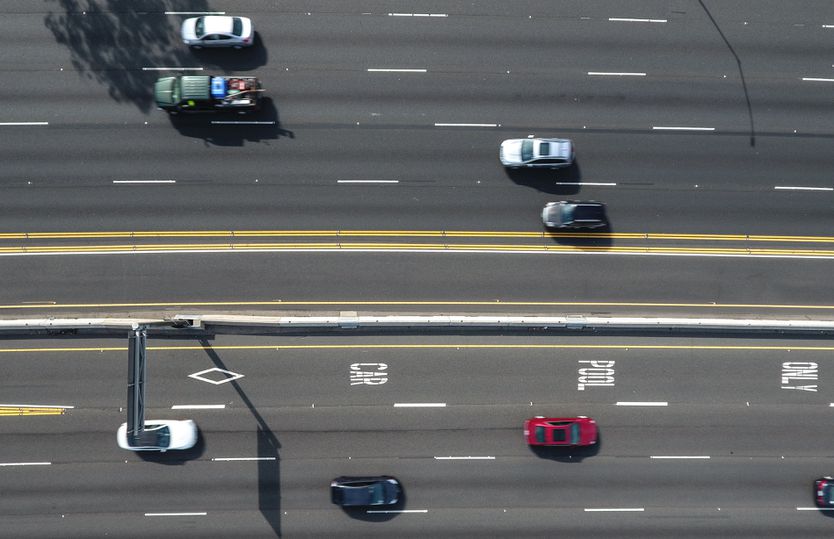Le covoiturage
Le covoiturage
Commençons par expliquer le terme "covoiturage". Certains synonymes que vous connaissez peut-être sont : partage de trajet ou partage de voiture. On parle de covoiturage lorsque les trajets en voiture sont partagés afin que plusieurs personnes voyagent dans la même voiture.
Cela permet de partager les frais de déplacement avec d'autres personnes, ce qui bien sûr profite à votre porte-monnaie. Si un nombre significatif de personnes participait au covoiturage, cela résoudrait le problème des embouteillages dans de nombreux endroits. Ou pensez simplement à la pollution de l'air croissante et aux émissions de CO2 générales. La règle reste la suivante : moins de voitures sur la route, moins d'embouteillages et de pollution.

Voies réservées aux VOM (Véhicules à Occupation Multiple) en Anglais: HOV
Le covoiturage est de plus en plus encouragé par les gouvernements du monde entier. Cela s'est manifesté par l'émergence des voies HPT (High Occupancy Vehicle lanes). carpooling is increasingly being promoted by governments all over the world. This has manifested itself in the emergence of HPT lanes.
HOV signifie "High Occupancy Vehicle" (véhicule à forte occupation). Certains pays ont déjà introduit l'utilisation des voies HOV. Il s'agit d'un compartiment de circulation séparé où seuls les véhicules à forte occupation sont autorisés à circuler, tels qu'un bus ou une voiture avec 3 ou 4 occupants.
Une voiture a souvent une capacité de 4 sièges complets. Mais dans la grande majorité des voitures, il n'y a qu'une seule personne, le conducteur. En conséquence, la plupart des voitures ne seront pas autorisées à utiliser les voies HOV, ce qui signifie que vous atteindrez souvent votre destination beaucoup plus rapidement en empruntant une voie HOV qu'en utilisant les voies de circulation normales (embouteillages, etc.).
Comment cela fonctionne-t-il?
Grâce
aux caméras ANPR, il est possible de compter assez précisément le nombre
d'occupants d'une voiture donnée. Pour commencer, nous avons besoin de deux
caméras ANPR qui peuvent lire à la fois la plaque d'immatriculation à l'avant
et la plaque d'immatriculation à l'arrière de la voiture. Bien sûr, nous devons
aussi savoir combien de personnes se trouvent réellement dans la voiture
À cette fin, nous allons placer 2 autres caméras ROV entre les 2 caméras ANPR (ROV = Reconnaissance Occupants Véhicule). Ces caméras ROV sont orientées vers le pare-brise et les fenêtres latérales de la voiture.
Ces 4 caméras envoient ensemble
toutes les données à un système back-office qui, à son tour, les convertira en
informations précieuses, telles que le véhicule qui utilise la voie réservée
aux véhicules à fort taux d'occupation, la plaque d'immatriculation liée à ce
véhicule et le nombre d'occupants comptés.
Il faut indiquer à l'avance avec quelle plaque d'immatriculation et avec combien d'occupants un véhicule va emprunter la voie réservée aux véhicules à haut taux d'occupation. Il est ainsi parfaitement possible de vérifier si un véhicule donné est censé ou non emprunter la voie réservée aux véhicules à haut taux d'occupation.
Filtre polarisé
The driver or occupants of a car are very often difficult to see on the screen, due to sunlight reflecting on the windscreen, rain, hail, ...
Heureusement, ce problème a été résolu en définissant un filtre polarisé pour la camera. Ce filtre élimine automatiquement toute réflexion sur le verre.
Comment un passager est-il détecté?Les caméras Macq CAM 5P sont équipées d'intelligence artificielle. Pour clarifier : l'intelligence artificielle est qualifiée ainsi lorsqu'un artefact affiche une forme d'intelligence. Cela permet à la caméra d'identifier des visages et ainsi de compter le nombre d'occupants dans une voiture. Il est important de savoir que seules les personnes peuvent être détectées ici, et non l'identité de ces personnes ou qui elles sont.